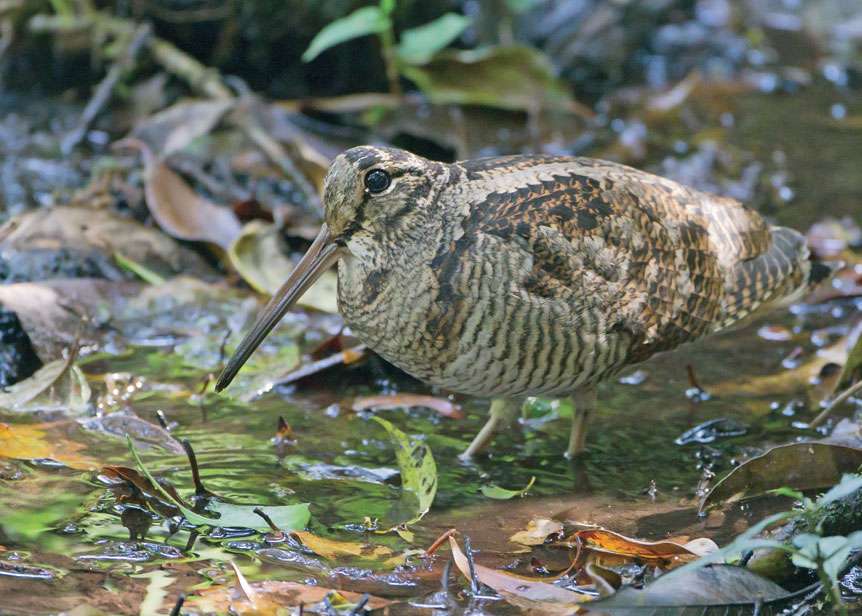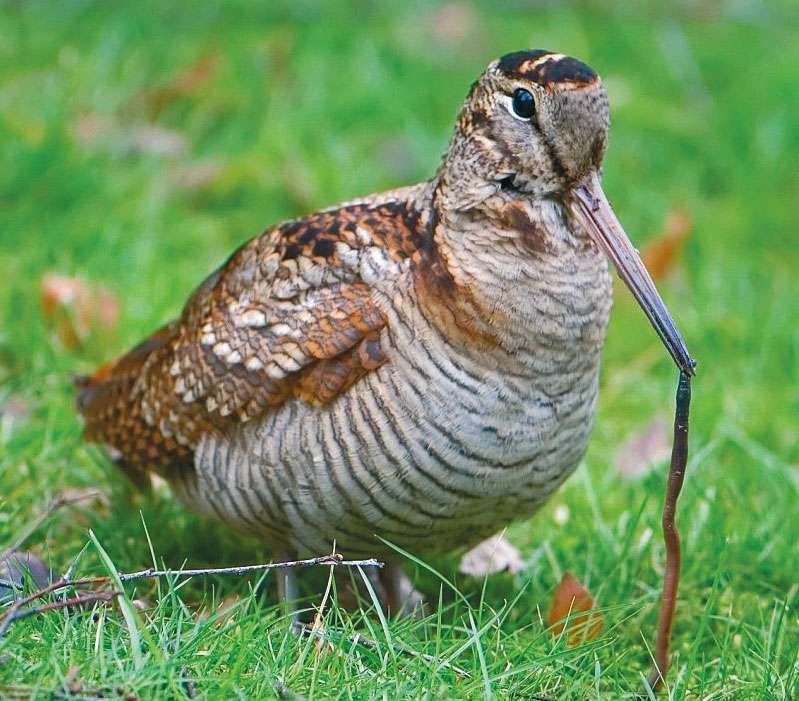
Woodcock on a search for food
This month, weather permitting, provides probably the last chance of the season to witness one of the magical moments in UK birding. And it unfolds right here on our doorstep. The Surrey heaths are one of the best places to see this impressive spectacle – and those around Cranleigh are no exception. As the sun sets on a fine summer’s evening the action begins to unfold. We are out in the open on one of the sandy tracks leading through a patchwork of heather, bracken and silver birch scrub.
It is getting much quieter now with notably less Gatwick and Heathrow aircraft interference. The last of the Song Thrush’s daily repertoire pulsates out from the bordering woodland of Scot’s pine and oak while a Robin gives a plaintive sub song before turning in for the night.
But not everything is bedding down. Other voices are taking over for the night watch. Distant Tawny Owls begin to call to one another from each direction of the compass while a bat buzzes us so close overhead we can hear it ‘ticking’. As we scan west above the outline of treetops the sky is now a vast orange glow. Then we hear it. A high-pitched squeak in the distance. And then a few grunts followed by another explosive ‘pssssp.’ Two hundred metres away, and side on to us, a black silhouette moves rapidly against the glowing backdrop of the sun’s dying embers. Its broad, stiff wings are slightly de-curved and seem to be working overtime to keep its podgy body airborne.
Suddenly it gives another squeal followed by a couple of croaks and veers off at right angles. It is flying just above tree height and is coming directly at us. Now we begin viewing it more clearly. Its dark colour turns into a tapestry of intricate rufous and buff barring on the underparts and we see a similar pattern under one of the wings as the feathers catch the last rays of sunlight.
But what stands out most of all on this pigeon-sized bird is its long, straight bill. It is around twice the length of the head and is designed for probing the earth for worms, beetles and insect larvae. We are witnessing a male Woodcock in full ‘roding’ mode. Roding involves repeatedly flying noisily around the circumference of a particular woodland and heathland territory to stake a claim on a particular patch and impress any female into mating.
If you are a Woodcock, and more than one female fancies teaming up, then you don’t argue. Some of the greedy big boys are said to have fertilised as many as four. With another squeak and a couple of grunts the bird speeds across the middle of the heath and flies along the treeline before diving off into the woods. But we will wait. If Woodcocks could speak then they’d always depart with Arnold Schwarzenegger’s iconic words in The Terminator: ‘I’ll be back.’
Woodcock feeding on a worm
And sure enough, five minutes later, our Woodcock returns. Flying the same circuit. Uttering the same strange sounds. This time he is suddenly joined by another and there is an airborne tussle as he gives chase. I can’t tell if it is rivals fighting or excited lovers. Oh well, as Arnie would say: ‘Hasta la vista, baby’. For me, while there is this action, that’s probably tomorrow. Seeing a resident Woodcock is not easy unless you go in the breeding season when they are roding.
This wading bird prefers to stay on the forest floor most of the time, where it feeds and nests. It can be accidentally disturbed by dogs, walkers, or mountain bikers who stray from the set paths so, if you can, do encourage other countryside users to keep to the marked routes. When flushed the female has even been observed flying up silently and protecting a chick by carrying it off with her between her legs.
And sure enough, five minutes later, our Woodcock returns. Flying the same circuit. Uttering the same strange sounds. This time he is suddenly joined by another and there is an airborne tussle as he gives chase. I can’t tell if it is rivals fighting or excited lovers. Oh well, as Arnie would say: ‘Hasta la vista, baby’. For me, while there is this action, that’s probably tomorrow. Seeing a resident Woodcock is not easy unless you go in the breeding season when they are roding.
This wading bird prefers to stay on the forest floor most of the time, where it feeds and nests. It can be accidentally disturbed by dogs, walkers, or mountain bikers who stray from the set paths so, if you can, do encourage other countryside users to keep to the marked routes. When flushed the female has even been observed flying up silently and protecting a chick by carrying it off with her between her legs.
Even if you know one is in the undergrowth just a few feet in front of you, its cryptic plumage provides excellent camouflage and it can be extremely hard to see. That’s one reason why we don’t know as much about the species as we would like to. What we do know, sadly, is Woodcock numbers are severely decreasing due to a variety of factors.
Two years ago it was upgraded from ‘amber listed’ to ‘red listed’ as a bird of conservation concern. It is threatened by increased woodland fragmentation, changing structures as forests mature, and the rising numbers of roe deer. If allowed to roam unchecked then the increasing number of pet dogs also cause unnecessary disturbance to Woodcock – and of course the many other ground nesting birds on our heaths.
Twitter – @Crane_Spotter ![]()












